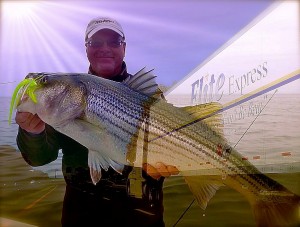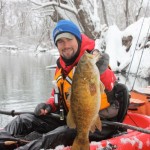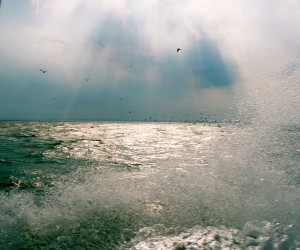bunker
I could hear the excitement in my fishing partner, Jamie Clough’s voice as he scanned the cloudy Chesapeake horizon with his binoculars.”
“Big birds!”
I slammed my 27′ Judge Center Console into gear and Thunder Road was off to the races. Up ahead, through the misty rain, we could see big herring gulls as they swooped and circled high over the water. As if on cue, a group of six or eight birds plunged toward a swirl on the surface. A savage fight ensued and the victor flew away erratically as the other gulls gave chase. In the lead bird’s beak was a 6-inch long silver fish.
“They’re on big bunker. That’s what we’re looking for,” shouted Jamie.
We bolted toward the spot where the birds were diving with our rods and reels at the ready. Before the boat came to a complete stop, we were both hooked up.
“Fish on!”
How was your fishing this fall? By most accounts, it’s been a great season for light tackle casting on the Chesapeake Bay. One of the reasons why we’re catching more fish than ever this year is that, thanks to recent harvest reductions, there is a lot of bait around, especially menhaden. In the Chesapeake, anglers refer to menhaden as bunker or sometimes (incorrectly) LYs. They’ve famously been called, “the most important fish in the sea.” That’s because menhaden are such a critical link in the Atlantic’s food web. At one time, menhaden made up over 70% of rockfish diets. Now, that number has dwindled to something like 8% because there just isn’t enough menhaden to keep the rockfish fed. In fact, the population of menhaden in the Atlantic Ocean is at less than 10% of historic levels. That’s a big drop and a huge problem, not only for recreational fishermen, but for anyone who makes their living in and around the Bay. Read More!
 Tell someone where to catch a Chesapeake Bay striped bass and you may help them for a day, but teach them how to identify specific seasonal patterns, and you’ve put them on the express route to becoming an elite fisherman. The fall migratory run is on. This is the time of year when the learning curve drops significantly and stripers feed voraciously. They aren’t too picky about the kind of baits they’ll take and they aren’t as choosy about lure presentation. It’s a great time to learn how to cast lures for big fish. It’s also the time when I step up on my “think patterns, not places” soapbox. Ask any accomplished angler their secret to repeated success and they’ll tell you it’s the ability to identify specific feeding patterns. I believe that you can drop a good fisherman into any body of water in the world and he’ll catch fish as long as you give him enough time to recognize prevailing patterns. Pattern recognition is especially important on the Chesapeake where conditions change quickly. Fortunately, fish are creatures of habit and we can identify predictable characteristics in their behavior.
Tell someone where to catch a Chesapeake Bay striped bass and you may help them for a day, but teach them how to identify specific seasonal patterns, and you’ve put them on the express route to becoming an elite fisherman. The fall migratory run is on. This is the time of year when the learning curve drops significantly and stripers feed voraciously. They aren’t too picky about the kind of baits they’ll take and they aren’t as choosy about lure presentation. It’s a great time to learn how to cast lures for big fish. It’s also the time when I step up on my “think patterns, not places” soapbox. Ask any accomplished angler their secret to repeated success and they’ll tell you it’s the ability to identify specific feeding patterns. I believe that you can drop a good fisherman into any body of water in the world and he’ll catch fish as long as you give him enough time to recognize prevailing patterns. Pattern recognition is especially important on the Chesapeake where conditions change quickly. Fortunately, fish are creatures of habit and we can identify predictable characteristics in their behavior.

I fished this past Saturday with a new fishing buddy, Jeff Little. You may have heard of Jeff because he’s well-known in the kayak fishing world for his instructional DVDs and videos about smallmouth fishing. Fortunately for Chesapeake Bay fishermen, he’s been bit by the striper bug. I’ve teamed up with him to produce some videos that illustrate my most successful techniques. Stay tuned because we’ll soon be posting one we shot Saturday about striper fishing in the fall on the Chesapeake Bay. We’ll launch a short preview first. If you like it, you can watch the action-packed 30-minute version for just $2.49. Read More!



